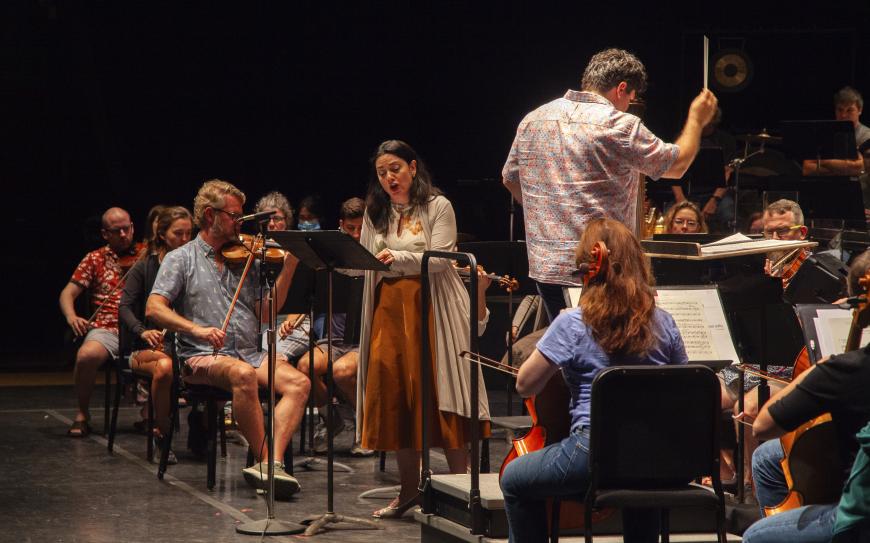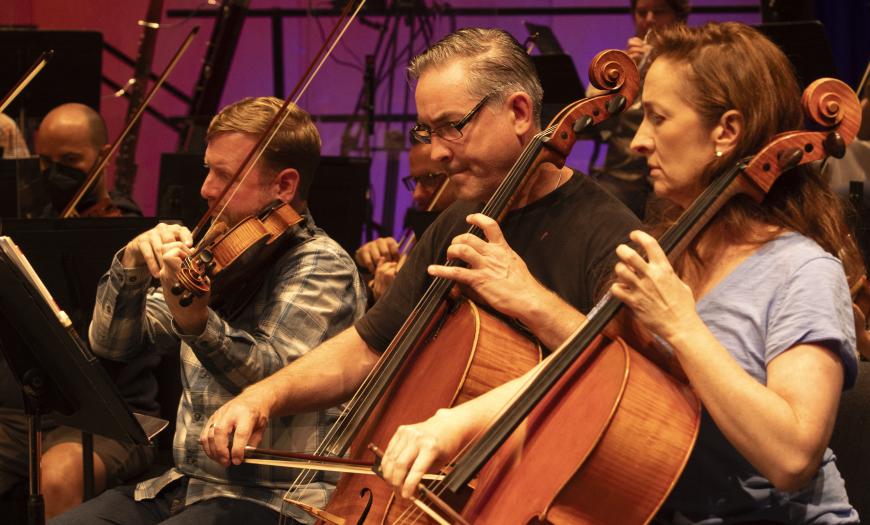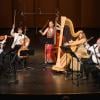
The theme of this year’s Cabrillo Festival of Contemporary Music is “Music as Movement,” and the festival named its opening-night program “Parade.” One famous musical parade immediately came to mind: the procession that appears and vanishes out of sight in “Fêtes” from Claude Debussy’s Trois Nocturnes.
Another, unstated theme of the evening might have been works with many, many ideas that don’t always cohere. This was the case with the first three pieces on the program.
Friday’s concert, conducted by Music Director Cristian Măcelaru, opened with the West Coast premiere of Canadian-born composer Vivian Fung’s Parade, a 2023 work that incorporates Fung’s responses to the isolation of the COVID-19 pandemic and the feelings of community that followed once people could gather again. In 2022, her son marched in the San Francisco Chinese New Year Parade, and in composing Parade, Fung wanted to “express conflicting feelings of chaos and melancholy, at the same time as empathy and gratitude,” as her program note for the piece states.
Parade incorporates part of a chant by Hildegard of Bingen in an opening where long notes in the lower strings might also invoke thoughts of the prelude to Richard Wagner’s Das Rheingold. Fung’s piece is very quiet for most of its roughly 10-minute length, with prominent parts for harp and marimba, but the work becomes quietly chaotic and eventually quite loud. At one point, the piccolo seems to take over the orchestra. It’s a parade that engulfs the listener and never lets up.

The bigger work on the first half of the program was the West Coast premiere of Scottish composer Helen Grime’s Violin Concerto. Running about 22 minutes, this 2016 concerto has three contrasting sections that loosely correspond with the three movements of a typical Classical- or Romantic-era concerto. The outer sections are wilder than the quieter, more contemplative middle section.
It’s a good thing that the great violinist Leila Josefowicz was on hand as the soloist. She’s among the foremost performers of complex new music for the violin, and she played this concerto with the intense commitment and technical brilliance that she brings to everything.
Grime wrote the solo part at the extremes of the instrument. The first movement is very fast and spends a lot of time in the upper reaches of the violin’s range. Complex rhythms and double stops abound. The celesta and harp are the violin’s primary foils in the orchestra, coloring the accompaniment beautifully.
Toward the end of this movement, the orchestra thins out for a quiet transition into the second movement. Here, the violin repeats phrases that are interspersed with the orchestra. The sound of the winds and percussion sometimes suggests birds. The last movement is extremely fast and violent; in her spoken introduction, Grime described the finale as a moto perpetuo.
Nina C. Young’s Tread softly was commissioned by the New York Philharmonic for its Project 19, which is celebrating the ratification of the 19th Amendment with 19 commissions to 19 women composers. This 15-minute work, like Parade and Grime’s Violin Concerto, is full of ideas, manifested by many shifts among seemingly different sound worlds. For example, a brief violin solo is followed by klezmer-like music. The moods shift every couple of minutes, from agitation to floating quietly, then back to raucous and back to quiet again.

These first three pieces, though very different, had in common rapid shifts of mood and a sense that their structures were neither primarily melodic nor harmonic. They’re all colorfully orchestrated, but it was hard to tease out just how they’re structured. The works weren’t well served by the Sahara-like acoustics of the Santa Cruz Civic Auditorium, which has essentially no reverberation to warm and meld the orchestral sound. I had to wonder whether playing these scores less percussively might have helped them cohere. I’d certainly like to hear them in a different sonic environment.
The concert closed with the world premiere of Canadian American composer Karim Al-Zand’s Al Hakawati (The storyteller), four fragments drawn from the composer’s opera in progress The Book of Tales. The fragments, three arias and an instrumental dance, focus on Scheherazade, Murjana, and Tarina Safar, the three main female characters in the opera.
This was perhaps the most conventional and immediately attractive music on the program, composed in a melodic style that sometimes incorporates the general sound of North African or Middle Eastern music. The “Dance of the seven swords” was suitably vigorous and percussive. Soprano Miriam Khalil sang the three arias with a beautiful dark sound and expressive intensity. There are stories to be told, and Al-Zand tells a good musical story. We can hope to hear the whole opera one day.




